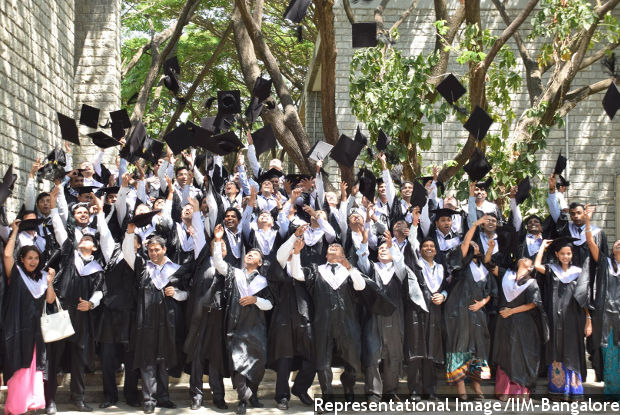
As many as 44.81 million–16.6% male and 9.5% female–Indian undergraduate students aged between 18 and 24 are too poor to pursue higher education, according to data from the National Sample Survey (NSS), 2014.
Source: National Sample Survey report, 2014; figures in percentage
As many as 34.2 million students were enrolled in institutions of higher education in 2014-15, according to the 2016 All India Survey on Higher Education (AISHE) report of the ministry of human resources and development (MHRD).
Nearly 22 million students (65%) are enrolled in private institutions in various courses.
Source: * 12th Five Year Plan , # All India Survey on Higher Education 2014-15 report ; figures in percentage
Private sector accounts for more than 76% of total institutions of higher education, data from the AISHE 2014-15 report show.
There are 712 central and state universities, 36,671 colleges and about 11,445 stand-alone diploma-level institutions across the country.
While government-owned institutions for higher education increased from 11,239 in 2006-07 to 16,768 in 2011-12 (49%), private sector institutions recorded a 63% growth in the same period from 29,384 in 2006-07 to 46,430 in 2011-12, according to the 12th five-year plan document of the erstwhile Planning Commission.
The first decade of the 21st century witnessed expansion of higher educational institutions, according to this mission document of the National Higher Education Mission (known as Rashtriya Uchchatar Shiksha Abhiyan – RUSA), a programme run by the University Grants Commission.
Forced to enroll in private institutions
Around 53% college students are enrolled in private institutions because there are not enough public higher educational institutions, according to the 2014 NSS report we previously quoted.
Source: National Sample Survey Report, 2014; figures in percentage
Students have also been drawn to short-term diploma and certificate courses because of their employability prospect. Secondly, there is huge shortage of public institutions offering such courses, data show.
Nearly 64% students enrolled for diploma and certificate courses in private institutions would rather be in government-run institutions, according to the NSS report.
So, while there is high demand for public higher educational institutions, successive governments have failed to meet the demand, pushing students towards expensive and, very often, low quality private education.
Commodification of education and exclusion
Private (out-of-pocket) expenditure on education for general courses has increased from Rs 2,461 per student in 2007-08 to Rs 6,788 per student in 2014 (175.8% increase), according to the two NSS reports on education published in 2007-08 and 2014.
Source: National Sample Survey report, 2014
The T.S.R. Subramanian Committee report on New Education Policy, submitted in 2016, admitted that uncontrolled privatisation of higher education has resulted in the proliferation of private institutions for higher education.
Most of these institutions are nothing more than shops selling degrees, according to the report. “While there are a few (institutions) which can be identified as ‘Centres of Excellence’, both in the public and private sectors, there are a large number which are mediocre, some of them could well be described as ‘degree shops’.”
Fees at private institutions are more than double those charged by government institutions, according to the NSS report.
Private institutions keep the cost of education high, despite restrictions on generating profit.
Ernst and Young, a global auditing and consulting agency, estimated that the market of Indian higher education is worth around Rs 46,000 crore and is expanding by 18% annually, Mint reported on September 10, 2013.
Source: National Sample Survey report, 2014
The private sector accounts for around 74% of enrolment in technical and professional courses because it has market demand, according to the NSS report. Yet, it shares only 39% of enrolment in general under-graduate and postgraduate courses.
Privatisation of higher education major hurdle in increasing enrolment
Low gross enrolment ratio (GER or percentage of potential students enrolled in educational institutions in a given year) in higher education has been a concern in India compared to other emerging economies in the world.
The GER of higher education has increased from 10% in 2004 to 23.6% in 2014, according to MHRD data. Despite the increase, India’s GER (23.6%) is the lowest among major emerging economies such as Brazil (46%), China (30%), Russia (78%) and South Africa (20%), according to World Bank data.
This GER in higher education is less compared to the number of students completing their school education (higher secondary) in the age group of 14-17 years. The GER of students in the age group 16-17 year was 49.1% in 2014, according to MHRD data.
So, more than half the students aged between 16 and 17 years did not enroll for higher education after completing schooling.
Successive governments have argued that allowing private sector in higher education would lead to higher enrolment. It was with this objective that both state and centre governments allowed expansion of private educational institutions in the last 10 years.
While it is true that GER in higher education has recorded growth during this period, the increased cost of higher education due to privatisation has deprived millions of aspirants from education.
High level of GER in higher education has direct co-relation with public financing, according to the mission document of RUSA.
Higher per capita expenditure on higher education in some states has resulted in better GER. For example, the per capita expenditure of Goa is Rs. 14,634 and the GER is 33.2%. Similarly, the GER of Tripura is 32.9% with Rs 13,104 per capita expenses. The GER of Andhra Pradesh is 28.4% with per capita expenditure Rs 5,892, according the mission document of RUSA.
Global experience also suggests that higher public investment in education yields positive results, according to the mission document of RUSA.
This article was republished from IndiaSpend.com.